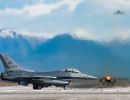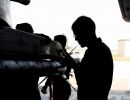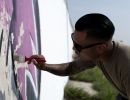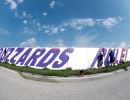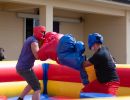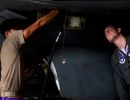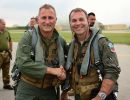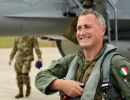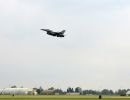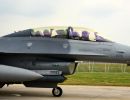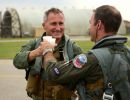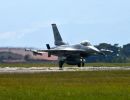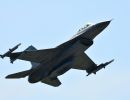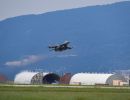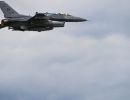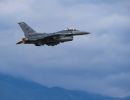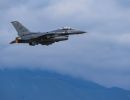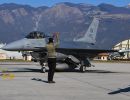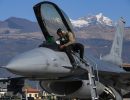The F-100 began life as a company funded project to improve on the basic F-86 Sabre design. The program didn't attract military interest until the F-86 was pitted against the Russian MiG-15 in the skies over Korea. Early Korean War experience made it evident that the Communist Bloc had brought themselves close to their western enemies in fighter design. The U.S. Air Force, not content with this, awarded North American Aviation a contract to produce two YF-100A prototypes and an F-100A production version in Nov. 1951. Thus was born the first of the century series fighters.
It made its initial flight on May 25, 1953, and the first production aircraft was completed in October 1953. The Super Sabre became the first fighter to attain level flight supersonic speed, doing so during its maiden flight Oct. 29, 1953. The F-100 became operational in Sept. 1954. North American built 2,294 F-100s before production ended in 1959.
Because the first of their number was designated the F-100, the USAF supersonic fighters developed in the 1950's were aptly christened with the appellation "Century Series." Design studies of an F-86 equipped with a thin 45° swept wing, known as the Sabre 45, marked the genesis of the F-100; but the aircraft that finally emerged with that designation was an entirely new machine.
The low-mounted wing had a sweepback angle of 45° a taper ratio of 0.25, and an airfoil-section thickness ratio of about 7 percent. Like the wing of its ancestor the F-86, the leading edge was equipped with automatic slats for stall control and the trailing edge incorporated plain flaps. Location of the ailerons mounted a short distance inboard of the tip reduced adverse wing twisting due to aileron deflection. Under conditions of high dynamic pressure, adverse wing twist due to aileron deflection can become so large that, on some aircraft, roll takes place in a direction opposite to that intended. This condition is known as aileron reversal.
The low-mounted horizontal tail of the F-100 assists in preventing pitch-up. As a further assist to stall control, most models of the F- 100 had wing fences. The variable-area nozzle is necessary for efficient operation of the afterburning engine.. The petals of the nozzle open to a larger diameter for afterburning. The boxlike structure on the vertical tail about one-third of the span from the tip housed a radar warning antenna.
The oblong nose inlet provides an immediate recognition feature of the F-100 series of aircraft. As compared with a circular inlet, the oblong design provides better pilot visibility over the nose and, since the duct passes under the pilot's seat, the vertical dimension of the fuselage is reduced at this location. No area ruling was incorporated in the design of the F-100.
All new aircraft encounter problems of varying degrees of seriousness, particularly in new and largely unexplored regimes of flight or with new configuration concepts, and the F-100 was no exception. An unanticipated problem was encountered during flight tests of the F-100 that resulted in loss of the aircraft as well as its well-known North American test pilot. Compared with piston-engine fighters and earlier jets, aircraft such as the F-100 had much higher values of the ratio of lengthwise to spanwise mass. As a consequence, a gyroscopic couple that caused large yaw excursions occurred during dive pull-out maneuvers accompanied by large rolling velocities. During the performance of such maneuvers in an early model F-100, the angle of yaw became so large that the aerodynamic loads on the vertical tail exceeded its structural strength and the tail separated from the aircraft. A larger and stronger vertical tail solved the problem on the F-100. All new fighter aircraft under development at that time, however, were carefully scrutinized for possible "rolling pull-out" problems; this maneuver is now a standard one that must be analyzed on all new fighter designs.
Maximum speed of the F-100D was 927 miles per hour, or Mach 1.39, at 35 000 feet; at sea level, the maximum speed was just below the sonic value. Maximum sea-level rate of climb was 22 400 feet per minute, or about three times that of the F-86, and the service ceiling was 51 300 feet. With a lift-drag ratio of 13.9 at subsonic speeds, the F-100 had a ferry range of 1971 miles. The combat radius was 599 miles with maximum external fuel load and 279 miles with only internal fuel and six Snakeye bombs.
Designed originally to destroy enemy aircraft in aerial combat, the F-100 later became a fighter-bomber. It made its combat debut during the Vietnam conflict where it was assigned the task of attacking such targets as bridges, river barges, road junctions, and cantonment areas. As a fighter-bomber, armament consisted of four 20-mm cannons mounted in the bottom of the fuselage below the cockpit with provision made for up to 6000 pounds of external ordnance such as bombs and rocket pods. The F-100 had originally been designed as an air superiority fighter, but the original "A" model was the only pure air superiority version. The "B" model was an all weather fighter. As the Air Force began to realize the F-84 fighter-bomber fleets were showing signs of age, the logical choice was to modify the F-100. Thus was born the F-100C. The F-100C which made its first flight in 1955, featured such advances as an in-flight refueling system, provisions for extra fuel drop tanks and bombs under the wings and an improved electronic bombing system. The "D" model was the definitive version with 1,274 examples eventually produced. It had improvements in both aerodynamics and weapons delivery, capable of carrying nuclear weapons.
General characteristics:
* Crew: 1
* Length: 50 ft (15.2 m)
* Wingspan: 38 ft 9 in (11.81 m)
* Height: 16 ft 2¾ in (4.95 m)
* Wing area: 400 ft² (37 m²)
* Empty weight: 21,000 lb (9,500 kg)
* Loaded weight: 28,847 lb (13,085 kg)
* Max takeoff weight: 34,832 lb (15,800 kg)
* Powerplant: 1× Pratt & Whitney J57-P-21/21A turbojet
o Dry thrust: 10,200 lbf (45 kN)
o Thrust with afterburner: 16,000 lbf (71 kN)
*Zero-lift drag coefficient: 0.0130
* Drag area: 5.0 ft² (0.46 m²)
* Aspect ratio: 3.76
Performance:
* Maximum speed: 750 knots (864 mph, 1,390 km/h)
* Range: 1,733 nm (1,995 mi, 3,210 km)
* Service ceiling: 50,000 ft (15,000 m)
* Rate of climb: 22,400 ft/min (114 m/s)
* Wing loading: 72.1 lb/ft² (352 kg/m²)
* Thrust/weight: 0.55
* Lift-to-drag ratio: 13.9
Armament:
* Guns: 4× 20 mm (0.787 in) M39 cannon
* Missiles:
o 4× AIM-9 Sidewinder or
o GAM-83 Bullpup
* Bombs: 7,040 lb (3,190 kg) of weapons, including
o Conventional bombs or
o Mark 7 nuclear bomb or
o Mk 28 nuclear bomb or
o Mk 43 nuclear bomb or
o Mk 57 nuclear bomb or
o Mk 61 nuclear bomb nuclear weapons


